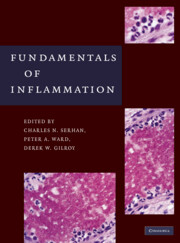Book contents
- Frontmatter
- Contents
- Contributors
- Preface
- PART I THE INFLAMMATORY RESPONSE – AN OVERVIEW
- PART II INDIVIDUAL CELL TYPES
- PART III CHEMICAL MEDIATORS
- PART IV IMMUNOPHARMACOLOGY
- PART V INFLAMMATORY DISEASES/HISTOLOGY
- 20 Lung
- 21 Neural Inflammation, Alzheimer's Disease, and Stroke
- 22 Rheumatoid Arthritis/SLE
- 23 Gastrointestinal Inflammation and Ulceration: Mediators of Induction and Resolution
- 24 Inflammatory Skin Diseases
- 25 Kidney Glomerulonephritis and Renal Ischemia
- 26 Inflammation in Cardiovascular Diseases
- PART VI ANIMAL MODELS OF INFLAMMATION
- Index
- References
22 - Rheumatoid Arthritis/SLE
from PART V - INFLAMMATORY DISEASES/HISTOLOGY
Published online by Cambridge University Press: 05 April 2014
- Frontmatter
- Contents
- Contributors
- Preface
- PART I THE INFLAMMATORY RESPONSE – AN OVERVIEW
- PART II INDIVIDUAL CELL TYPES
- PART III CHEMICAL MEDIATORS
- PART IV IMMUNOPHARMACOLOGY
- PART V INFLAMMATORY DISEASES/HISTOLOGY
- 20 Lung
- 21 Neural Inflammation, Alzheimer's Disease, and Stroke
- 22 Rheumatoid Arthritis/SLE
- 23 Gastrointestinal Inflammation and Ulceration: Mediators of Induction and Resolution
- 24 Inflammatory Skin Diseases
- 25 Kidney Glomerulonephritis and Renal Ischemia
- 26 Inflammation in Cardiovascular Diseases
- PART VI ANIMAL MODELS OF INFLAMMATION
- Index
- References
Summary
RHEUMATOID ARTHRITIS
Rheumatoid Arthritis: Clinical Case
A 60-year-old man presented with a 4-week history of a gradually worsening ankle pain and swelling. He gave no history of morning stiffness, or symptoms in any other joints. There was no preceding history of infection (including of the gastrointestinal or genitourinary tract) and no history of previous inflammatory disease (including the skin and eye). There was a family history of rheumatoid arthritis with his daughter having been diagnosed with this condition at the age of 30. He smoked 10 cigarettes per day and drank 6 units of alcohol per week. He had been treated with diclofenac by his primary care physician but had derived little benefit from this.
On examination, he had tenderness with clinically apparent synovial swelling at the left ankle (Figure 22.1A). The remainder of the physical examination was normal.
The differential diagnosis of an inflammatory monoarthritis includes septic arthritis and crystal arthritis and to exclude these diagnoses the patient underwent an ultrasound guided joint aspiration (Figure 22.2). No organisms were identified on synovial fluid microscopy or culture and no crystals were seen on polarized light microscopy. Further investigations revealed the following: ESR 16 mm/h, CRP 17 mg/L (normal < 5 mg/L), rheumatoid factor 72 IU/mL (positive > 20 IU/ mL), anti-CCP antibody 81 U/mL (positive > 10 U/mL), chest radiograph normal.
- Type
- Chapter
- Information
- Fundamentals of Inflammation , pp. 267 - 281Publisher: Cambridge University PressPrint publication year: 2010



